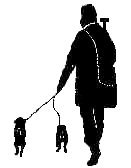
RatDog
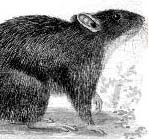 Introduction Introduction
Rats, and their associated lice and
fleas, have killed more people than all
wars combined. We have trapped them,
poisoned them, drowned them, gassed them
and still they keep coming ... Now it's
time to turn the dogs on them! This
RatDog web page is devoted to terrier
ratting -- an ancient and honorable
pastime going back hundreds of years. If
you own a terrier, then you own a ratting
machine who's DNA is coded to do a job.
|
| |
 The Rat:
A Survivor The Rat:
A Survivor
Where do we start? Rats are used
in labs to save lives and measure
intelligence, they have steered rockets
in space, and they have not only
survived, but thrived, on nearly every
poison thrown at them. They can swim 2
miles out to sea, dive more than 50 feet,
exert bite pressure of 24,000 pounds, and
chew through drywall and metal. Female
rats spend almost 100 percent of their
life pregnant. >> To read more fast facts
about rats
|
| |
 Entering Dogs to
Rats Entering Dogs to
Rats
Most dogs will readily work
rats, and rats are a common quarry to
start off a young dog. At four months a
dog can be started off on wild mice
trapped with a "tin cat" live
trap available from most pest control
stores. Place the mouse in a small wire
cage to stimulate the dog's interest and
then release the mouse once it appears
the dog wants to do more than sniff. The
same protocol can be followed with rats,
albeit with a larger live-catch trap. You
can also purchase "feeder" rats
at a pet store.
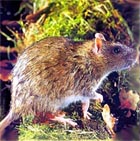 Starting
a dog off slow builds its confidence.
A novice dog will try to bite a rat to
death instead of shaking it, but most
will figure out that a quick shake will
snap the rat's back in record time. To
get your dog to use its nose, place a rat
in a wire cage and hide it in a shed, or
in the garden. You can make a scent line
to the cage with a "tea" made
from soaked rat cage bedding. In no time
at all your dogs will be looking for rats
on their own. Starting
a dog off slow builds its confidence.
A novice dog will try to bite a rat to
death instead of shaking it, but most
will figure out that a quick shake will
snap the rat's back in record time. To
get your dog to use its nose, place a rat
in a wire cage and hide it in a shed, or
in the garden. You can make a scent line
to the cage with a "tea" made
from soaked rat cage bedding. In no time
at all your dogs will be looking for rats
on their own.
|
| |
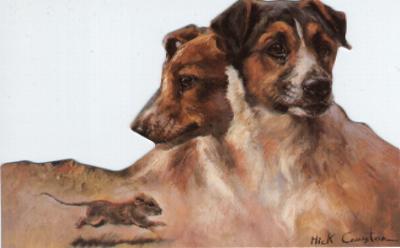 When and
Where to Go When and
Where to Go
Rats
prefer to live as close as possible to
their food and water sources. Most
of their movement is within 150
feet of their home and almost all
activity outside of the burrow will
occur in the twilight, dark of the night,
or very early morning. In choosing
a neighborhood to settle into, rats look
for overflowing or uncovered dumpsters,
trash in plastic bags or unsealed cans,
spilled grain, rotting vegetables, and
abandoned debris in which to easily
hide. Rat holes in the ground are
an obvious sign of infestation, but so
too are gnaw marks around holes in horse
stalls or building siding. Look too for
rub or grease marks which will give you
an idea of where rats are regularly
running along a wall when entering a
building.
......Unless you use a
smoker, most of your rat hunting will
take place at night, which means you need
to have a dog that is obedient. You
should also patrol the area during the
day to make sure that rat poison has not
been set out.
|
| |
Working With Your
Dog
Rats generally live and feed within a
circle of few hundred yards of where you
see them. The rats know this territory
like the back of their paw, which means
your dog doesn't have much of a chance to
achieve a high kill ratio unless you help
it out a little. One way to do that is to
disorient the rats by making mild
alterations to their stomping grounds.
Move a board or two, place a cardboard
box in a new location, set a coke bottle
up on end, and scuff your heel in a sharp
line or two in the dirt to make a little
furrow or trench. All of this serves to
alter the rat's visual cues and to break
up the invisible but very important scent
trails that rats use to
"triangulate" their position
(like we would use a road or a cross
street). Another important step is
to block as many escape holes as
possible. A disoriented rat that
hits a blocked hole will be confused just
long enough for the dog to nail it. Rat
holes do not need to be blocked with
anything more substantive than a bit of
wadded up newspaper. Finally, use
more than one dog. The more dogs
that are working a rat-infested area, the
less likely that a rat will be able to
scurry off to safety, and the more
disoriented the rats will become.
|
| |
| |
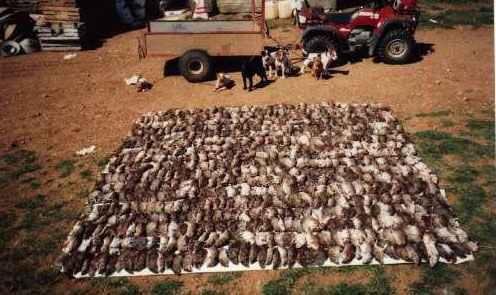 About
900 rats taken from a game farm
in England with a pack
of terriers and a smoker. With
modern poisons, health
inspections, and hygiene regimes,
very few farms are infested with
rats at this level any more.
|
|
| |
| |
| |
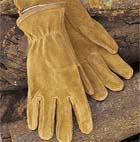 Equipment Equipment
Very little equipment is needed for
ratting. A shovel is useful, as is a
hooked piece of rebar to use when lifting
boards and shaking or beating on piles of
rubbish. A flashlight is required if you
are out at night. Gloves are needed
regardless of when you hunt. A plastic
bucket for dead rats may be useful, as
might salad tongs if you are a bit dodgey
about picking up dead rats. The most
useful piece of equipment is a
"smoker" to drive rats from
their dens. This can be made by attaching
a hose to the exhaust manifold of a small
engine, such as an old chainsaw that has
had its chain and bar removed. Add
a little extra oil to the mix to increase
the smoke. You will need to add a
length of metal pipe to the manifold port
in order to help dissipate the heat from
the engine (weld on a screw thread and
then twist on a 4 foot of pipe on the
site). You should look for a flexible
hose that does not melt easily as plastic
garden hose will melt in short order if
close to the exhaust. A good tip is to
seek out black radiator hose from an
auto-parts store; it can take a lot of
heat. |
| |
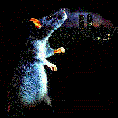 Precautions
Against Disease Precautions
Against Disease
Rats can transmit at least 35
diseases to humans, including
leptospirosis (very common) and the
plague (very rare). Other diseases
transmittable by rats include: typhus,
rabies, tularemia, trichinosis,
leishmaniasis, spirilary rat bite fever,
and spirochetal jaundice. The most common
disease your dog can get from a rat is
leptospirosis, but the chance of this
occurring can be dramatically decreased
if you prevent your dog from drinking out
of puddles. >> For more information |
| |
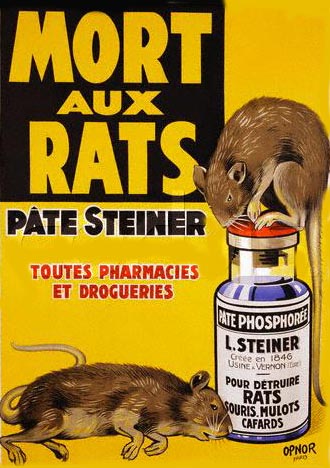 The War on Rats The War on Rats
It seems every large city and every Third
World country periodically declares
"war on rats." Rats never sue
for peace, and humans never declare
victory. Considering the fact that rats
can get fat on poison that would kill a
linebacker, and have thrived on Pacific
atolls devastated by atomic bombs,
perhaps we should just give up.
>> To read about the
"war on rats" in Washington,
D.C.
>> To read about the
"war on rats" in New York City
>> To read about the
"war on rats" in India &
China
>> To read about the
"war on rats" in Vietnam |
| |
 Rat
or Ratatouille? Rat
or Ratatouille?
Some
people think cows are sacred and pigs are
filthy and never to be eaten.
No one thinks twice about eating
a bit of mutton or a nice rabbit or
chicken, but most recoil at a bit of dog.
I have eaten snake (quite good) but
shudder at eating eel, though everyone
tells me it is excellent, especially if
smoked. Squirrel and groundhog? No
problem. Possum? Not on a bet. In every
culture, one man's rat is another man's
ratatouille, and the rules of cuisine do
not always make perfect sense. Food for
thought as you read this entertaining New
Yorker article. >>
To read more |
| |
 Books on
Rats and Hunting Rats Books on
Rats and Hunting Rats
nTales of a
Rat-Hunting Man by Brian Plummer is
the best rat-catchers tale ever penned.
Plummer describes the rat as "the
unheralded game-animal of Great
Britain," and recounts great stories
and techniques hard-learned over a life
time of ratting and earth work.
nMore Cunning Than Man:
A Social History of Rats and Man
by Robert Hendrickson is an
eye-opening, well-researched examination
of mankind's oldest competitor and
is filled with weirdly fascinating
information about the history of the rat
and the way it consistently outsmarts
man.
nThe Rat : A Perverse
Miscellany by Barbara Hodgson is
packed with rat facts, rat fiction,
rat lore, rat art, and more. Quick-paced
and fun-to-read, this compendium
explores the unsinkable rat in fables,
folklore, novels, pulp fiction, and
horror flicks.
nRats, Lice, and History
by Hans Zinsser is an old but great book
that is part history, part literature and
part humor. It should be on
everyone's shelf.
nFull Revelation of a
Professional Rat Catcher by Ike
Mathews. First published in 1898, this
little book has been republished in
recent years and is available from
Coch-y-bonnduu books. A fun read.
|
| |
 Our
Patron Saint: Our
Patron Saint:
The "Patron Saint" of all rat
dogs is Teddy Roosevelt who created the
American Rat Terrier and worked rats in
the basement of the White House.
|

|
|
|
